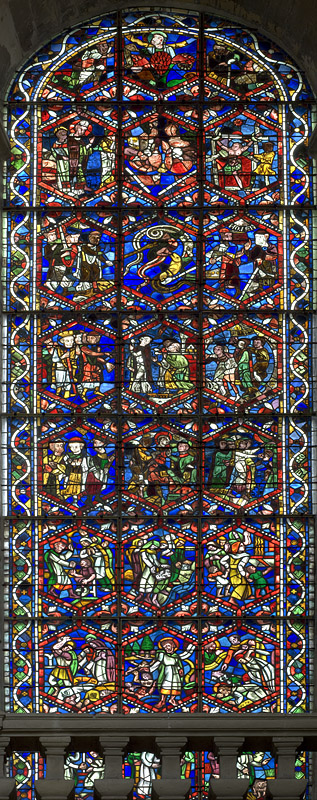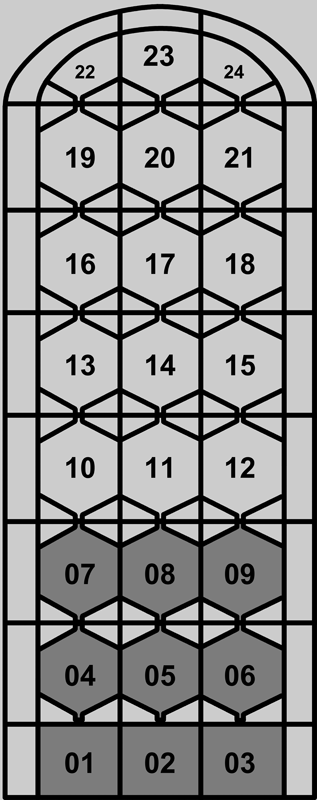
Bay 113b - Mixed Panels from Exodus and from a Life of St Blaise
(All images © Dr Stuart Whatling)


Panels from Exodus:
22-23 - God speaks to Moses from the burning bush (Exod 3)16-18 - Aaron's rod eats the other rods (Exod 7:10-12)
20 - The skies rain fire and hail upon Egypt (Exod 9:23)
13 - Pharaoh releases the Israelites? (Exod 12:31)
14 - Moses leads the Israelites out of Egypt? (Exod 13:19)
15 - Moses instructing the Israelites?
10 - Unidentified scene with three men
Panels from the Life of St Blaise:
24 - An elderly widow's pig is snatched away by a wolf19 - St Blaise visits the old widow whose pig was stolen
12 - Blaise's female followers dump the idols into a pond
11 - The prefect gives the order for Blaise's execution
21 - St Blaise is tortured with iron combs
Overview:
A mightily confusing window! There are some panels here which are obviously scenes from the Book of Exodus but
there are others which are equally obviously hagiographic. The most likely explanation is that the designers of the Poitiers
glazing programme used an identical medallion pattern (three upright hexagons per register) for two windows -
presumably an Exodus window on the north side of the choir and a Life of St Blaise facing it on the south side.
At some point a restorer has gathered together the 15 panels that survived (out of what would have been an original 48,
assuming the current pattern is correct) and assembled them in a form that was at least aesthetically pleasing, even if the
resultant narratives made little sense. Chigot then added his usual modernist panels to fill in the remaining gaps at the bottom.
Where this suggestion runs into difficulty however is that this window includes scenes of Moses witnessing the burning bush, the seventh plague and (possibly) the Israelites leaving Egypt, whilst the adjacent window (113a), with its design consisting of pairs of roundels, includes the first plague and other scenes that should interleave with these ones. It is possible that the original windows were comprised of alternating registers with two roundels and three hexagons each, although even this explanation is tricky because the positions of the vertical glazing bars in the two windows do not match.
Where this suggestion runs into difficulty however is that this window includes scenes of Moses witnessing the burning bush, the seventh plague and (possibly) the Israelites leaving Egypt, whilst the adjacent window (113a), with its design consisting of pairs of roundels, includes the first plague and other scenes that should interleave with these ones. It is possible that the original windows were comprised of alternating registers with two roundels and three hexagons each, although even this explanation is tricky because the positions of the vertical glazing bars in the two windows do not match.